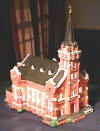

Model of St. Mary Magdalen Catholic Church (1911)
CURRENTLY SOLD OUT
The Society began a "Model Village" project in 2002. The first entry was a miniature scale model of the 1907 St. Mary Magdalen Catholic Church in Abbeville, designed by "Abbeville's stellar architect," George Honold. It is of ceramic construction and comes with a light inside. The first two shipments sold out quickly.

Model of Bank of Abbeville (1903)
The second model in the series is the historic Bank of Abbeville building. This building facing Magdalen Square is probably the most recognizable Abbeville building. It was built in 1903, replacing a smaller bank that stood on a portion of the same property but was destroyed by fire. The architect for this building was also George Honold, who designed so many of Abbeville's beautiful buildings. The first shipment of model banks sold out quickly.

Model of Palms Hospital (Fenwick Sanitarium) (1907-1969)
CURRENTLY SOLD OUT
The third model in the series is the Palms Hospital (Fenwick Sanitarium), another masterpiece of architecture by George Honold. This building was completed in 1907, replacing a building destroyed by fire. It has the appearance of a tropical hotel, and in fact was used as a hotel for a time. Many of the residents of Vermilion Parish were either born in this hospital or treated there.

Model of Audrey Hotel (1928) (Abbeville City Hall)
CURRENTLY SOLD OUT
The fourth model in the series is the Audrey Hotel (1928), currently serving as the Abbeville City Hall. This is the first building in the series that was not designed by George Honold. The building is unique in the sense that the walls are constructed of poured concrete. After being vacant for many years, the city of Abbeville purchased the building and remodeled the first floor for its offices. When first built, the hotel offered dancing on the rooftop, and many senior Abbevillians remember dancing there.

Model of School Board Office (first high school) (1903)
CURRENTLY SOLD OUT
The fifth model in the series is the Vermilion Parish School Board Office (1903). This building was also designed by George Honold. It was the first high school in Abbeville. Later it became Abbeville Elementary School, and many Abbevillians alive today attended school there. It has been used as the school board office for some years now.

Model of Vermilion Parish Courthouse (1953)
CURRENTLY SOLD OUT
The sixth model in the series is the Vermilion Parish Courthouse (1953). This building was designed by renowned Louisiana architect A. Hays Town. It replaced the brick courthouse that was erected in 1891. It sits on the courthouse square dedicated to the public by Rev. Antoine Désiré Mégret, founder of Abbeville.

Model of the Frank's Theater (1931)
The seventh model in the series is the Frank's Theater (1931). This theater was built by early Abbeville movie entrepreneur Frank DeGraauw. It is historic not just for its age but for having hosted the southern premiere of the award-winning documentary Louisiana Story. This theater was for a time called the Dixie Theater before returning to its original name. Frank's Theater is currently being restored by The Allumé Society, with the intention of making it a usable venue for the exhibition of films, live performances, and meetings.

Model of the Abbeville Railroad Depot (1892)
The eighth model in the series is the Abbeville Railroad Depot (1892). This depot was built when the Iberia & Vermilion Railroad reached Abbeville. This old building was rescued in March, 2000, by Charles and Mary Ellen Sonnier, who moved it a few blocks, remodeled and restored it, and opened a gift shop in it called "The Depot at Magdalen Place."
Subsequent buildings have not yet been decided upon, but some of the suggestions so far are: the 1891 courthouse, the Veranda Hotel (stood where the City Hall now stands), the Victor Theater (currently Bernard Duhon law office), the Solomon Wise building (Landry Stores/Black's Restaurant), the Eli Wise home, the Caldwell House, the Masonic temple, the Episcopal Church, the Methodist Church, the Catholic Rectory, the Abbey Players building, and the Wells Fargo building. Send us feedback if you have other suggestions.